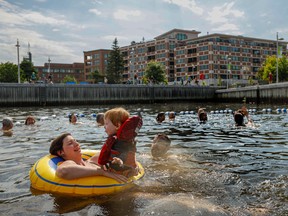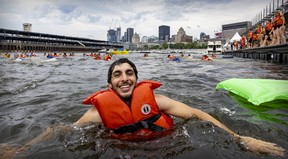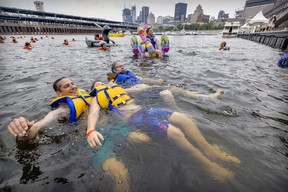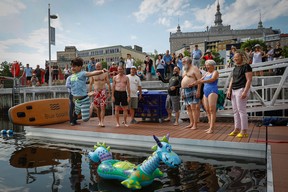As rising water levels cause erosion, landslides and other changes to the landscape at a rate never seen before, an expert report calling for action on climate change has been ignored.

Article content
Quebec City inaugurated its new “harbour bath” on July 1, about 30 years after swimming enthusiasts started agitating for safe, public access to the waters of the St. Lawrence River in the provincial capital.
Advertisement 2
Article content
Bounded by floating docks, the new harbour bath, called the “Oasis du Port de Québec,” is the size of an Olympic swimming pool, with five swimming lanes separated by cables. Eventually, a floating wading pool for kids and a 625-square-metre “relaxation zone” will be added for those who don’t want to swim lengths. Harbour baths are popular in Europe, but the Oasis is the first of its kind in North America.
The new facility is good news for anyone concerned about the future of the St. Lawrence River. And experts say there is serious cause for concern.
Back in March of 2020, as news of the global pandemic dominated the media, a group of more than 80 experts calling themselves the Great Lakes and St. Lawrence Collaborative quietly released a report calling on the federal government to invest $1 billion over the next decade to protect the St. Lawrence River from the impacts of climate change and toxic substances.
Advertisement 3
Article content
More than 60 per cent of Quebecers live along the shores of the St. Lawrence River system, which drains more than 25 per cent of the world’s freshwater reserves. So you would think the report, called Action Plan 2020-2030 for the Future of the Saint Lawrence, would have made waves.
But because of the timing of its release, it was all but ignored, and no substantial funds were committed to its 12 key recommendations in the last federal budget. Among the threats to the river outlined in the report are: repeated and more frequent flooding, coastal erosion, toxic algal blooms, and bacteriological contamination from untreated wastewater and agricultural runoff.
These threats are not all caused by climate change, but they are all caused by human activities, and climate change is only worsening their impacts on the people, animals, birds, fish and plants that rely on the river for survival.
Advertisement 4
Article content
One of the plan’s key recommendations was for governments and municipalities to provide more and better public access to the St. Lawrence River by opening new beaches and other types of public access points along its shores. Access is key to getting people to care about the river, says Aurélie Sierra, an environmental sociologist who sat on one of several thematic roundtables of experts consulted to produce the Action Plan.
“Improving and maintaining access to the St. Lawrence is a great way to create awareness, because it’s a way to get closer to the river and to create a link of belonging, which might create a desire to protect it,” says Sierra, whose consulting company, Atelier Social, helps organizations and governments adapt to climate change.
Advertisement 5
Article content

Another key recommendation of the plan is to improve wastewater treatment in shoreline communities and introduce regular, state-of-the-art water quality monitoring programs at existing and potential swimming areas along the river. Recent testing has shown the water at Quebec City’s Basin Louise, where the new harbour bath is located, is consistently clean enough for swimming. But that is not the case all along the river.
“There are more beaches on Great Lakes shorelines than on the St. Lawrence, and a regulatory regime has been in place for years in Ontario, whereas Quebec lacks a regulatory framework for beaches management and quality,” said a followup report by the expert collaborative, released in June of 2020.
Advertisement 6
Article content
Since 1999, the provincial government has been monitoring the potential for adding beaches or swimming docks along the river, studying the bacteriological quality of water at 48 sites between Montreal and Île d’Orléans. Some of these sites were historic beaches that closed in the last century due to pollution, some are currently in use and some were chosen because they have good esthetics or good potential for public access.
Since 2003, 16 “sentinel sites” have been monitored weekly almost every summer, and according to the most recent update, the majority of those sites had “good” or “very good” potential for safe swimming on average between 2017 and 2019.
But water quality varies greatly from site to site. Based on E. coli concentrations, four of the sites received a rating of “good” (21 to 100 colony-forming units per 100 ml of water), seven were “fair” (101 to 200 CFUs/100 ml) and four were “poor” (more than 200 CFUs/100 ml, the amount above which contact with the water is deemed unsafe). Only one of the sites got a rating of “excellent” (0 to 20): l’Île Charron Park, in Longueuil. Tellingly, that site is upstream from the sewage discharges off Montreal Island’s east end.
Advertisement 7
Article content
Montreal’s $700-million ozonation wastewater treatment plant, scheduled to open in December 2024, should go a long way to improving water quality along the St. Lawrence. Bacteriological contamination increases immediately downstream of the Montreal area, and studies show the bacterial plume from the Montreal urban area is still perceptible at the outlet of Saint-Pierre Lake in Trois-Rivières. If the ozonation technology works as promised, water downstream from Montreal should be substantially cleaner beginning in 2025. But other municipalities need to invest in wastewater treatment and other measures to reduce the amount of raw sewage that gets flushed into the river when heavy rains cause sewer overflows. And more needs to be done to reduce pollution from agricultural runoff, the report notes.
Advertisement 8
Article content
“In the context of climate change, where a greater number of extreme rainfall events is predicted, combined with higher temperatures that will undoubtedly lead to Quebecers wanting to cool off by swimming, such action will prove essential,” the latest update from the St. Lawrence Monitoring Program concludes.
But water quality is only one of the issues experts are concerned about when it comes to the future of the St. Lawrence River system. Rising water levels are causing erosion, landslides and other changes to the landscape at a rate never seen before.

“We have to prepare ourselves psychologically for the changes that are coming … for the losses,” says Sierra. “There is a kind of grieving to be done because yes, effectively, the water will rise and erosion will eat into the land.”
Advertisement 9
Article content
So just as Quebecers are beginning to value their river and demand better access to its shores, the waterfront is changing.
“Access to the river is primordial, to create beaches and other types of access points while respecting the ecosystem … is really important, in Montreal as well,” says Sierra.
“Nonetheless, we have to prepare ourselves for the fact that there is a lot of erosion. The level of the St. Lawrence is rising, a lot. It will continue to do so over the next years, evidently. So, we have to prepare ourselves to be flexible with that. It means we will give ourselves some access points and those access points may disappear, so we have to be ready to create other access points.”
Sierra says people must get their minds around the fact that climate change is already here and changes to the physical environment are now inevitable, if not completely predictable.
Advertisement 10
Article content
“We have to work with the population in terms of adaptation, to get them used to the fact that their environment, their swimming places, their strolling places, all that will change. … Those swimming areas that we’ve known for years, that have always been the same, won’t (necessarily) exist anymore in future years. Oka Beach, for example, will end up disappearing, clearly. The water will rise and there will be no more (beach) at all,” she said.
Scientists have not pinpointed when Oka Beach, for example, could cease to exist, she said, but it is time to accept that rising water levels will dramatically affect Quebec’s waterways and shorelines. The landslides in the Saguenay last month and flooding in Ontario and Quebec in recent years are only the beginning.
Advertisement 11
Article content
“We always talk about climate change in the future, but the reality is that it is the present,” said Sierra. “It is not going to start in 10 years. We are in it and the impacts are here. We see it with these floods. It is quite clear. These flooding episodes are more and more frequent and more and more intense. Towns like Rigaud and Gatineau experienced that in a very violent way in the last few years.”

None of this is surprising to climate scientists. A 2015 study by Ouranos — a Quebec-based consortium on adaptation to climate change — predicted more than 5,400 buildings (mostly residential) in the Lower St. Lawrence, Côte-Nord, Gaspésie and Îles de la Madeleine would be destroyed by coastline erosion by 2065 if no adaptation measures were implemented. Almost 300 kilometres of roads and 26 km of railways would also disappear, and the economic losses were estimated at the time at $1.5 billion.
Advertisement 12
Article content
The COVID-19 crisis has made the public more aware of the importance of protecting natural spaces, says Jean-Éric Turcotte, director of Stratégies Saint-Laurent, a non-profit organization that co-ordinates regional efforts to protect the river.
“We sense, not just since COVID, but over the last decade, that the St. Lawrence is more and more at the centre of public awareness. And that’s great. We have a lot more people mobilizing, participating in our activities. … In terms of the sense of belonging in the St. Lawrence and nature in general, we sense a good momentum at this time.”
Turcotte and others are hoping the public will get behind the push for more beaches and access points along the river, and then lobby the government to invest in protecting the river. And floating facilities like the harbour bath in Quebec City may well be our best bet in this changing landscape.
-
An update on three Montreal-area projects that give public access to the river
-
Environmental groups and swimmers call for more beaches and swimming docks around the island of Montreal
-
Quebec releases updated map outlining zones at risk of flooding



